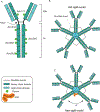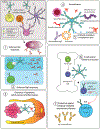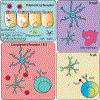Secreted IgM: New tricks for an old molecule
- PMID: 31302940
- PMCID: PMC6803036
- DOI: 10.1002/JLB.3RI0519-161R
Secreted IgM: New tricks for an old molecule
Abstract
Secreted IgM (sIgM) is a multifunctional evolutionary conserved antibody that is critical for the maintenance of tissue homeostasis as well as the development of fully protective humoral responses to pathogens. Constitutive secretion of self- and polyreactive natural IgM, produced mainly by B-1 cells, provides a circulating antibody that engages with autoantigens as well as invading pathogens, removing apoptotic and other cell debris and initiating strong immune responses. Pathogen-induced IgM production by B-1 and conventional B-2 cells strengthens this early, passive layer of IgM-mediated immune defense and regulates subsequent IgG production. The varied effects of secreted IgM on immune homeostasis and immune defense are facilitated through its binding to numerous different cell types via different receptors. Recent studies identified a novel function for pentameric IgM, namely as a transporter for the effector protein ″apoptosis-inhibitor of macrophages″ (AIM/CD5L). This review aims to provide a summary of the known functions and effects of sIgM on immune homeostasis and immune defense, and its interaction with its various receptors, and to highlight the many critical immune regulatory functions of this ancient and fascinating immunoglobulin.
Keywords: AIM; FcµR; autoimmunity; homeostasis; inflammation; secreted IgM.
©2019 Society for Leukocyte Biology.
Figures




